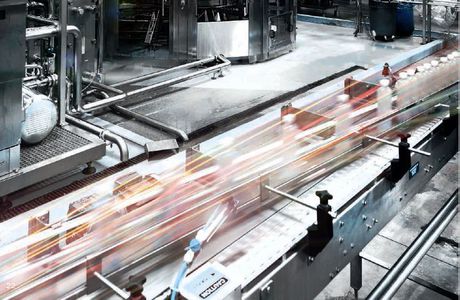Sensors in hygienic conditions

Sensors used in food processing must be designed to be able to withstand harsh clean-in-place procedures.
Achieving reliable results, even in harsh conditions, is particularly important in food production and processing. Supplying contaminated or inedible food can result in considerable financial losses and a damaged reputation.
One method of fulfilling the strict hygiene standards that apply in this context is to clean the systems using high pressure every day; however, this means that the individual components are exposed to strong thermal and mechanical loads as well as aggressive chemical cleaning agents, which presents a real challenge to sensors.
Organisations such as the EHEDG (European Hygienic Engineering & Design Group) and the American 3-A Sanitary Standards are developing guidelines for hygienic machine and system construction — including the components used in the systems. In an age of globalisation, we rely more and more on harmonisation between these guidelines and the certification criteria.
Washdown and hygienic design
Machines and systems which process foodstuffs are arranged in different zones in accordance with the relevant hygiene requirements:
Zone B
Zone B is also known as the splash, cleaning or washdown zone. Washdown indicates that the splash zone of a machine can be wet-cleaned well and quickly. With this type of cleaning, there will be little or no residues (foodstuffs, cleaning agents, water) left on the surfaces. Sensors in the splash zone must therefore be rugged when exposed to cleaning agents and high-pressure cleaning.
Zone A
Zone A is the foodstuff or hygiene zone. For ‘hygienically designed’ machines — and the sensors used in these machines — certain additional standards apply. A machine is considered to be hygienically designed if it remains free from product residues during use, as this forms an ideal breeding ground for germs. Consequently, it is important to avoid dead space and open joints when designing components.
Sensors that are designed in accordance with hygiene standards are constructed in such a way that they can be used directly in the foodstuff zone (hygiene zone) of a machine. Less build-up of product deposits means less cleaning, in turn reducing the amount of detergent, water and energy required. The system throughput increases thanks to shorter cleaning intervals — which can be an economic benefit, particularly if products are changed frequently.
The material makes all the difference
To ensure reliability while meeting the particular requirements of the food industry, sensors are manufactured in a range of housing materials.
Stainless steel (Inox)
Sensors enclosed in stainless-steel housing are chemically resistant, rustproof and durable. They guarantee chemical material resistance and absolute tightness during intensive cleaning and disinfection.
VISTAL
A high-strength plastic, reinforced with glass fibre, VISTAL offers mechanical properties exceeding those of conventional plastics. A VISTAL housing can reach a level of mechanical strength and tightness sufficient to receive a rating of IP69K.
PTFE
A PTFE coating ensures all-round protection for the sensors and cables. The PTFE plastic is not affected by solvents or other aggressive chemicals. Its surface is so smooth and slippery that hardly any external substance can stick to it, making it suitable for use in hygienic and wet areas.
Housings with an IP69K enclosure rating
Housings with an IP69K enclosure rating guarantee that the sensors and their accessories will stand up to intensive cleaning processes, regardless of whether these involve a high-pressure jet of up to 100 bar or water temperatures of up to 80°C.
Hygienic accessories
What use are hygienic sensors if the mounting components provide a breeding ground for germs? Mounting systems should also fully comply with EHEDG recommendations; for example, connecting cables can be made of PVC with M12 plug connectors for use in the food and beverage industry. With Ecolab certification and IP69K enclosure ratings, users can be sure that connecting cables are resistant to the cleaning agents and disinfectants for which they have been tested.
Originally published here.
Performance without compromise: enhancing manufacturing quality with single-controller solutions
Most factory automation systems today have mutiple control systems that don't communicate...
From wartime wisdom to smart manufacturing: the power of condition monitoring
The shift from reactive to predictive maintenance is really a cultural transformation empowered...
Efficiency in intralogistics: AMRs and industrial 5G
How industrial 5G enhances AMR applications and performance.







